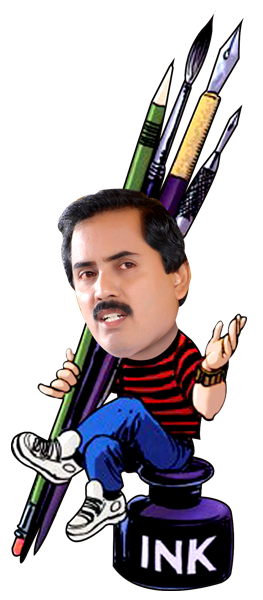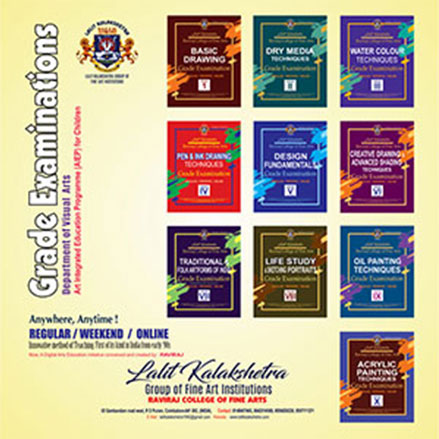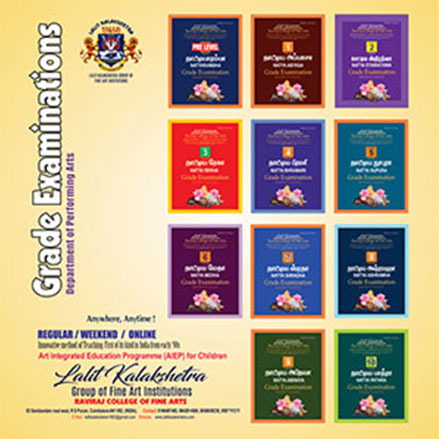
What for Grading System?
Our educational systems lay stress only on academic syllabus and do not promote the other extra-curricular activities. Unlike in foreign countries the Indian students do not have options to pursue their extra or co-curricular activities like Art & Design, Music, and Dance, etc., along with their academics.
Any form of Art, being versatile is difficult to evaluate, hence, we need a system which can make it acceptable by the practitioners and experts alike. Children tend to put in serious efforts when they are faced with the prospect of being examined. This gradation system will certainly make them to work harder and inspire them to practice with sincerity.
The ‘Gradation Certificates’ will make room for healthy competition among the talented students that will lead to more practice and better learning by them.
In the absence of Gradation system even a child with years of learning experience fails to get recognised. Parents are unable to understand or estimate the talent levels of their own children.
The continuity of learning Fine Arts is influenced by their academic goals in the competitive world. The children need their own liberty in identifying their interests and pursuing them along with academics.
Lalit Kalakshetra is the first Institution in India which has formed Grade system for children from yearly 90’s in a successive manner according to their competence levels.
What is Grade Examination?
Today the teachers are chosen by the parents mostly based on their popularity. The process of gradation of students trained by the teachers will stand testimony to the teaching skills of the individual teacher or the teaching institution.
Our Grade Examination is 10 Grade systems.
This Grade Exams is divided into 3 Levels:
- Basic Level (Grade: 1 to 4).
- Intermediate Level (Grade: 5 to 7).
- Advanced level (Grade: 8 to 10).
How to Apply?
- Children’s who wish to be graded should send in their application along with the exam fees to Lalit kalakshetra. (Students from other Institutions who wish to be graded should send their application along with the exam fees to Lalit kalakshetra, through their teachers)
- Separate Grade Exams are available for Art & Design, and Music & Dance
- The application will be processed, and candidates will be sent Hall Tickets through their Institution / School / teacher.
- Grade Certificate will be issued only for those who have cleared the grade
- Grade Examinations will be conducted twice in a year (July and January) Application with fees should reach on or before June and December every year.
Eligibility
- There is no age limit for any grade.
- Any student pursuing Art & Design, Music and Dance course can apply. No academic Qualification needed.
- Gradation scales are from 1 to 10. (However a student can apply for any grade directly based on their level of competence.)
- The grade to which the student can appear will be decided by respective teachers (approval by the authorities of Lalit Kalakshetra.)
- Examination will be conducted at our Lalit kalakshetra Centers only.
But outstation institutions examination will be conducted through online or offline with our invigilators only.
Assessment of Grade Exam:
- The exam is conducted with Theory & Practical’s and will be adjudged by a panel of examiners
- Instead of Theory, Oral exam component is also built in wherever required
- Grade Examinations will be conducted twice in a year (July and January)
Pre Grade for ART, MUSIC & DANCE
During the previous examinations, it was observed that fear of exams; anxiety and lack of preparation were the primary reasons for less than expected performance. We are glad to inform you that pre grade is being introduced in all the subjects which will be before Grade I.
Pre Grade will benefit in the following:
- To identify prodigies
- To increase confidence level.
- To overcome fear and anxiety associated with exams in fine & performing arts
- To give sense of pride in parents
- Pride of earning certification at a very young age
- To create interest in the respective subject
- To showcase latent talents
- To help children prepare better for Grade - I
Pre Grade Exams will have No age limit and there will be no theory, Fees INR. 500/-
| EXAM FEES | |||
|---|---|---|---|
| LEVEL | GRADE | (INDIA) | (OTHER COUNTRIES – In US $) |
| Basic Level | Grade (I to IV) | INR 1000 | 25 |
| Intermediate Level | Grade (V to VII) | INR 2000 | 50 |
| Advanced Level | Grade VIII to X | INR 3000 | 75 |
Candidates who skip the lower grades and apply directly to a higher grade shall pay additional INR 1000, for each grade skipped. subject to a maximum of Indian INR. 3000 (for other countries US$ 25, subject to a maximum of US$ 80)
Grade Exam Subjects
- Drawing and Painting
- Dance ( Bharathanatyam and Mohiniyattam )
- Music (Carnatic / Western)
- Carnatic: Vocal, Violin.
- Western: Guitar and Keyboard
Grade Exam Pattern
Music & Dance
There will be Two Papers (Theory and Practical) :
Practical - 80%
- Grade 1 - 4 will be for 5 to 10 minutes
- Grade 5 - 7 will be for 15 minutes
- Grade 8 - 10 will be for 30 minutes
Theory - 20%
- (Written or Oral)
- Grade 1 - 5 will be for 30 minutes
- Grade 6 - 10 will be for one hour
Drawing & Painting
( 2 Hours for Theory and Practical)

CHILDREN’S DIVISION
The ARTS are all about your imagination! Anything you can dream of you can create with some type of Art! And Art is everywhere! From when you wake up in the morning until you go to sleep at night, art is a part of everything you do! What kind of Artist would you like to be? One of the most basic forms of VISUAL ART is DRAWING!
ART EDUCATION
(Art Integrated Education Programme (AIEP) for School Children) Syllabus revised and prepared for professional course of study! – Strictly Not for Hobby classes!
Aim:
- To promote Observational Skills; Critical Thinking; Imagination; Creativity; Self Expression; Aesthetic Sense, Problem Solving Approach, Self-Direction, and 21st Century Skills!
- Curriculum covers stage by stage (considering their age group) for their future studies in Art & Design like B.Des., Fine Art, NID, NIFT, CEED, NATA – General Ability(GA) and Creative Ability(CA) – in entrance examinations and for other Fine Art and Design related courses!
- Main objective of our Art Integrated Education Programme (AIEP) is to make our students aware of the vast and diverse Cultural Heritage of our Country!
Dear Parents, Art & Craft Teachers!
Having 31 years of experience in teaching art to the children, we structured a new innovative world class curriculum designed by the nationally renowned Artist Mr. Raviraj, for the 21st century kids – The pedagogy, Theme, Style, Creativity, Medium, Projects and Assessments are carefully curated and prepared perfect lesson plans for different age groups. A special Refresher course also for Art Teachers to upgrade their skills!
Now, we also offering LIVE interactive online art classes for young Artists! Exactly as in-studio sessions, focused projects with fun. Each session children will create new masterpieces!
We classified 3 different ways of teaching and syllabus for Visual Art Education courses
- HOBBY ART COURSES – Online Art Classes! (In Studio and Virtual Studio)
- FOUNDATION COURSES FOR CHILDREN (Professional Standard) – (In Studio)
- GRADE EXAMINATIONS FOR CHILDREN (Art & Design, Music & Dance)
HOBBY ART COURSES
Online Art Classes! (In Studio and Virtual Studio)
ART STUDIO
ART FUNDAMENTALS -(Age Group 5 and above - In Studio and Virtual Studio – 10 Classes) Line, Shape and Colours, Nature, Birds and Animals by combining with line, shape and colours simplified. Fun with Colours…….
CLAY STUDIO
(Age Group 10 and above - In Studio only – 10 Classes) Clay Shapes & Forms, Animal Faces, Clay pendants, Painted bird hangings, Manual clay bowls, and pots, bowl and mugs using an electric potter’s wheel etc.,
CRAFT STUDIO
- (Age Group 5 and above - In Studio and Virtual Studio – 10 Classes) Gift wrap and tags, Spotty animal cards using templates, Paper hand bag, Paper frieze, paper spiral decoration, Origami, Decoupage, … etc
PRINT STUDIO
(Age Group 10 and above - In Studio only – 10 Classes) Leaf and vegetable prints, Cream Marbling, Sun print, Mono Prints, Screen Prints, woodcut prints etc.,
FOUNDATION COURSES FOR CHILDREN
(Professional Standard)
(Duration: Six Months) - In Studio only
SKETCHING AND DRAWING TECHNIQUES
- Introduction, Drawing Materials & Techniques, Making Marks – using HB, B, 2B, 4B & 8B pencils; the effect of the paper surface on the marks.
- Exploring other dry media.
- Marks with Colour Media – Soft Pastel, Pastel pencil, Oil pastel, Coloured pencils, Water soluble colour pencils, and Crayons.
- Mixed Media.
- Drawing Practice – using construction lines
- Drawing leaves, Fruits, and Vegetables.
- Birds and Animals.
- Negative Spaces
- Contour Drawing – object and group of objects.
- Expressionistic Drawing.
- Rendering Tone – Tonal Scale, Hatching and Crosshatching with pencil
- Blending shading with charcoal pencil
- Stippling.
- Working on a Large Scale.
- Light and Shadows.
- Texture and Pattern
- Pen and Brush Drawing.
- Line and wash
- Composition.
- Still Life (from artificial or natural objects);
- Painting from Nature.
- Coloured Pencils /Pastels
- Perspective and Buildings.
- Imaginative Composition
- Portraits
BASICS OF DRAWING & PAINTING
- Introduction, Getting to know the Materials, Making Marks – using HB, B, 2B, 4B & 8B pencils; the effect of the paper surface on the marks.
- Controlling the Form – Learning by doing – Sketch Book practice.
- Geometric Approach.
- Proportion.
- Establishing Measurements.
- Composition – Choosing interesting compositions.
- Analysing composition and layout.
- Simultaneous points of view – Fragment the Image.
- Light and Contrast – Drawing Shadows.
- Block Shading – Values.
- The Tonal range of Drawing – Gradations.
- The effect of Volume – Modeling.
- Detailed chiaroscuro drawing.
- The Third Dimension – Mathematical Perspective and Intuitive Perspective.
- Model and Background in a Still Life.
- Atmospheric Perspective – Perspective Tricks.
- Introduction to Painting – Materials and Methods.
- The World of Colour - Colour theory – Exercises.
- Earth Colours.
- Colour and feelings.
- Painting Flowers, Fruits and Vegetables.
- Painting Nature.
- Feeding your Imagination ( Hidden Ideas, Creative Doodling, Anything is possible, Fantasy creatures, Composition based on few lines from a famous lyrics, Resources for pictures and Collecting for a theme.
DRY MEDIA TECHNIQUES
- Introduction- Dry Media : Sketching Media, Dry Media and Oil-based media. – Drawing tools, Papers and other surfaces.
- Coloured Pencil Basics – Single uniform tone, Tonal Gradation, Overlap and blending.
- Lines – Straight and Curved lines, Diagonal lines, Crosshatching (colour mixing).
- Colours & Tones: Colour Wheel- Primary, Secondary, Complementary, Tonal values.
- Transparent Layering.
- Burnishing and wax blooming.
- Sgraffito
- Impressed Lines.
- Coloured pencil with Graphite.
- Rendering with Water-soluble coloured pencils.
- Flowers/Fruits
- Birds/Domestic Animals.
- Nature
- Working on Black Paper.
- Mixed Media.
- Project.
EXPRESSIONS IN WATER COLOUR
- Introduction – Water colour Materials and Techniques
- WaterColour Props, Extenders and Retarders
- Start with Detail study sketches
- Basic Washes: Plain washes, washes applied on one another (Overlap Wash), Flat Wash, Graded wash and variegated wash
- Exercises: Basic Colour Wheel
- Basic Techniques: Warming up, Proportion of water in watercolour painting.
- Flowers.
- Fruits.
- Foliage: Paint Shrubs &Trees with the Study of Basic Shapes & Washes.
- Monochrome or Dual Tone painting.
- Wet into wet.
- Wet on Dry.
- Masking out
- Pen and Ink.
- Different Techniques: Scraping, Using Salt, Sponges, Spatter, Wax resist, Masking Fluid.
- Landscapes
- Projects
RENDERING WITH PEN & INK
- Introduction- Papers & Boards: Illustration Boards, Bristol Boards, Stippled Board (Leather), Matt Art Board, Tracing papers, Scratch Boards; Designers Indian Ink; Coloured Drawing Inks;
- Pen Textures- Experiments with Ballpoint pen (Vertical, Horizontal, Quick short vertical, quick diagonal, Crosshatching, Short curved form lines, continuous form lines, circular patterns, vertical plus short lines, dots, dots and solid);
- Rendering with Quill pen/Dip pen/Metal pen/Pen holders; Copy works of Albrecht Durer’s – Six Pillows drawing, Young hare and praying hands.
- Brush Techniques – Basic brush strokes and textures.
- Rendering a Tree (Pen-Brush & Wash)
- Brush, Ink & Litho Crayon on stippled board;
- Scratch Board Techniques;
- Spatter Technique;
- Dry brush and chalk on toned paper.
- Pen and Ink Cartoons.
- Line and Tone – washes over pen lines;
- Pen & Ink using transparent photo colours;
- Lettering & logo design
- Using Bamboo pen/Felt pen/fibre tipped pen/wedge shaped marker;
- Illustration Techniques: Rendering with Brush pen /Pigma Micron pen /Uni-ball eye/Pilot Sign pen/ IDenti pen;
- Projects.
DESIGN FUNDAMENTALS
- Introduction to Design; Importance of Design; Free-arm exercises; Symmetrical, Asymmetrical, Enlarging and reducing;
- Common Objects drawn with straight lines;
- Cylindrical and conical objects; Objects based on the cone;
- Perspective; Colour Theory
- Drawing from Nature;
- Mechanical Drawing using geometrical instruments;
- Pattern Drawing using pen & Ink;
- Leaf & Floral forms in geometry, leaf curvature;
- Rose with decorative treatment; Birds and Animals forms;
- Pattern in Nature;
- Silhouette treatment of natural forms;
- Simple units for use in design (Motif);
- Elements and Principles of Design;
- Border Patterns; Design in Textile, Jewellery, Wood Carving, Interior and Fashion Industry;
- Skeleton and Panel fillings based on plant forms;
- Motif, Repeat, Pattern, Texture and Design Portfolio.
MIXED MEDIA TECHNIQUES
- Introduction – Materials: Paints, Brushes, Cardboard, Bubble wrap, Modelling paste, CDs, Hair combs, Old toothbrushes, Rubber cement, Tissue papers, Sand, Plaster of Paris, Old Magazines, Waxed paper, Tin foil sheets, Metallic markers, Toothpicks, Permanent markers etc.
- Line and Wash Techniques;
- Rendering with Drawing ink and Watercolour;
- Indian Ink illustrations with transparent photo colours;
- Combination of Ballpoint pen and watercolour;
- Collage
- Painted Mosaic
- Using modeling paste, Tissue paper, on cardboard.
- Crumpled foil techniques
- Drawing on Newspaper;
- Monoprints
- Vegetable printing
- Pencil and Watercolour
- White ink on Black paper
- Charcoal over watercolour
- Projects
CREATIVE DRAWING & ILLUSTRATION
- Introduction
- Copying Picasso’s – Five lithographed versions of a Bull
- Still Life – Perspective and distortion
- Simultaneous points of view – Fragment the Image.
- Many ways of seeing and saying
- Painting on Collage
- Illustrative processes – Thumbnails, roughs;
- Decorative Illustration;
- Metamorphosis
- Beyond reality
- Anthropomorphism
- Caricature
- Invented figures
- Inspirations from Nature
- Fabric paint and Paper collage
- Drip Technique
- Relief Technique
- Using Newspaper as a background
- Print and Stamp Techniques
- Coloured paper and pastels
- Pattern Printing
- Sandpaper Technique
LIFE STUDY TECHNIQUES
- Facial Features
- Principles of drawing the head
- Drawing head in various angles
- Women’s Head
- Expression
- Anatomy
- Drawing Hands
- Drawing leg and feet
- Vitruvian Theory
- Ideal Proportion for a male figure; Ideal Proportion for a female figure
- Various standards of proportion
- Understanding Perspective
- Figures in Perspective
- Block forms, Planes, Foreshortening
- Light and shade
- Figure in action; Drawing a life model
OIL PAINTING FOR BEGINNERS
- Introduction- Equipment’s
- Oil Painting – I
- Oil Painting – II; Oil Painting – III; Oil Painting – IV; (Colour Theory; Colour Mixing; Glazing; Impasto; Alla Prima )
ACRYLIC PAINTING FOR BEGINNERS
- Introduction: Brushes, Supports, Paint and Boards, Easel, Gesso, Latex, Retarder,
Glossy and Matt Medium, Gels, Modeling paste, Varnish; Acrylic Paint and its
properties; Colour Theory; Colour Mixing; Glazing; Impasto; Alla Prima; Spattering
and Spraying. Collage and Acrylics.
- Still Life
- Flowers
- Landscape
- Student Choice
SPECIAL COURSES
- ENTRANCE COACHING for - NATA, NID, NIFT, DJ, SRISHTI, DSK, CEED, PEARL
- PORTFOLIO PREPARATION
- FASHION ILLUSTRATION TECHNIQUES
- PHOTOGRAPHY
- ABACUS
- VEDIC MATHS
- CALLIGRAPHY
- ART & CRAFTS
- YOGA
- KARATE
PERFORMING ARTS
- DANCE – BHARATHANATYAM & MOHINIYATTAM
- MUSIC – VOCAL (CARNATIC & HINDUSTANI),
- INSTRUMENTAL ( KEYBOARD, GUITAR
- VIOLIN, MRIDHANGAM & FLUTE)



